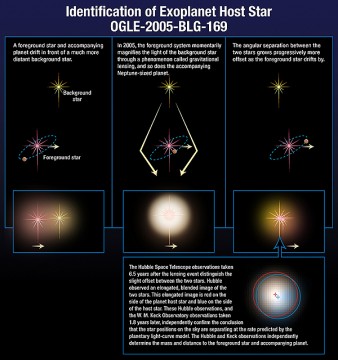Astronomers have confirmed the existence of an exoplanet found via microlensing — the first time they’ve been able to successfully follow up on this method.
One of various methods astronomers use to hunt for planets around alien stars is microlensing. In a microlensing event, one star passes in front of another from our perspective, and this alignment — within a fraction of a milliarcsecond (1/3,600,000°) — boosts the light of the background star. It’s as though the closer star is a magnifying glass, amplifying the farther star.

NASA / ESA / A. Feild (STScI)
If the closer, magnifying star has a planet around it, this planet can add an extra blip to the light curve of the boosted signal, which astronomers can detect. Astronomers can use the blip’s characteristics, such as its timing and magnitude, to calculate how far the planet is from its star and (indirectly) its mass.
Astronomers have found about three dozen exoplanet candidates via microlensing. But these candidates are difficult to confirm: observers need to either catch the closer star passing in front of another faraway star (statistically unlikely) or wait several years until the stars move far enough apart to see them as two separate signals instead of one. Only then can astronomers confirm each star’s physical characteristics, which they need in order to confirm the blip's nature.
Using this latter method, Virginie Batista (Astrophysics Institute of Paris) and colleagues have now confirmed a microlensing exoplanet’s existence. The team used images from the Hubble Space Telescope and the Keck II telescope on Mauna Kea to study the stars involved in the microlensing event OGLE-2005-BLG-169. A collaboration of amateur and professional astronomers discovered this system in 2005. Since then, the stars have moved farther apart in the sky; after several years, they were finally far enough apart for astronomers to tell the closer and farther star apart.
The analysis shows that the star is a K5 main-sequence star (still fusing hydrogen in its core, like the Sun), with a mass about two-thirds that of our star. It also confirms that the planet is 12 to 15 Earth masses (about Uranus’s mass) and orbits its star roughly 4 Earth-Sun distances out — that would put it on the outer edge of the main asteroid belt in our system.
This success shows that, with patience and superb images, astronomers can indeed confirm some of the microlensing exoplanet candidates.
You can read more about the result in the press release from the W. M. Keck Observatory and the Space Telescope Science Institute, or in the team’s two papers, which appear in the August 1st Astrophysical Journal. Below, you'll also find a short animation of the microlensing event (disclaimer: yeah, it's fuzzy, but the flash is neat).
Credit: NASA / ESA / D. Bennett (University of Notre Dame) / Wiggle Puppy Productions / G. Bacon (STScI)
References:
P. Bennett et al. “Confirmation of the Planetary Microlensing Signal and Star and Planet Mass Determinations for Event OGLE-2005-BLG-169.” Astrophysical Journal. August 1, 2015.
Batista et al. “Confirmation of the OGLE-2005-BLG-169 Planet Signature and Its Characteristics with Lens-source Proper Motion Detection.” Astrophysical Journal. August 1, 2015.
Like what you read? Only a fraction of our content appears online. Subscribe to Sky & Telescope magazine for more great astronomy content!
 0
0









Comments
You must be logged in to post a comment.